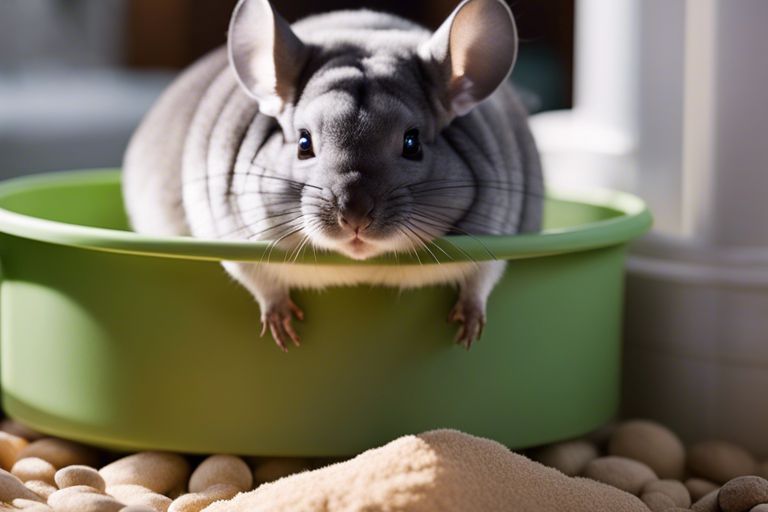Chinchillas should not go more than one week without a dust bath. These small, fastidious groomers rely on regular dust baths to keep their thick fur clean, remove excess oils, and prevent skin issues. Without dust baths, chinchillas may experience problems like skin irritations, fur matting, and even stress or lethargy. It is recommended that chinchillas have access to dust baths 2-3 times a week to maintain their fur and skin health.
Key Takeaways
- Chinchillas need dust baths 2-3 times per week to maintain healthy fur and skin.
- Going without a dust bath for more than a week can lead to skin conditions, fur matting, and behavioral issues.
- A dust bath is crucial for removing excess oils from their fur and preventing overheating.
- Chinchillas in humid environments may require more frequent dust baths to manage moisture buildup in their fur.
- Providing a safe, appropriate dust bath environment is essential to maintaining your chinchilla’s well-being.
Why Chinchillas Need Dust Baths
Chinchillas have very thick fur that easily traps oils, moisture, and dirt. Unlike many animals, chinchillas do not groom themselves with water because their dense fur can take a long time to dry, increasing the risk of fungal infections. Instead, they instinctively roll in dust to clean their fur, much like they would in the wild, where they use volcanic ash for grooming.
Benefits of Dust Bathing
- Removes excess oils: Dust baths help absorb and remove oils from the fur, keeping it soft and clean.
- Prevents fur matting: Regular dust baths prevent fur from clumping together, which can lead to overheating and skin issues.
- Supports mental well-being: Dust baths also provide enrichment, allowing chinchillas to engage in natural behaviors that reduce stress.
Frequency of Dust Baths
Chinchillas should have a dust bath 2-3 times per week, depending on their environment. Humid climates can cause moisture to build up in their fur, requiring more frequent dust baths, while chinchillas in drier environments may need fewer baths.
The Consequences of Skipping Dust Baths
Skipping dust baths can lead to a range of issues for chinchillas, both physical and behavioral.
Skin and Fur Health Risks
Without regular dust baths, chinchillas can develop:
- Fur matting, which traps moisture and oils, leading to overheating.
- Skin infections or fungal issues, such as dermatitis, caused by excess oil and moisture buildup.
- Dry, flaky skin, leading to discomfort and potential scratching or irritation.
Behavioral Implications
Dust baths are not just for cleaning; they provide enrichment and satisfy natural instincts. Without dust baths, chinchillas may become bored or stressed, which can lead to:
- Fur chewing or pulling.
- Chewing on cage bars or other objects.
- Increased restlessness or agitation.
Recommendations for Chinchilla Dust Bathing
To ensure your chinchilla stays healthy, it’s essential to provide them with a safe and effective dust bathing environment.

Creating a Safe Dust Bathing Environment
Here are some key tips for creating a dust bath area:
- Use a chinchilla-specific dust, made of volcanic ash, to mimic their natural environment. Avoid using sand or other dust types, which can cause respiratory issues.
- Choose a large, stable container: Ensure the dust bath container is large enough for your chinchilla to roll around in comfortably. Place it in a quiet, draft-free area to avoid stress.
- Time limits: Leave the dust bath in their cage for around 10-15 minutes per session to prevent over-drying of their skin.
Special Considerations
While dust baths are essential for chinchillas, there are certain situations where dust bathing might not be possible due to health or environmental concerns.
Dust Bath Alternatives During Health Issues
If your chinchilla has a respiratory illness or skin condition that prevents dust baths, consult with your veterinarian for alternatives. You may be able to use dust-free wipes or other veterinary-recommended products to maintain your chinchilla’s fur without causing harm.
Monitoring Your Chinchilla’s Grooming Habits
Keep an eye on your chinchilla’s grooming behaviors. Excessive scratching, fur loss, or changes in grooming habits can signal underlying health issues such as arthritis, dental problems, or skin infections. Regular vet visits and close monitoring will help you address these issues early.
Conclusion
Chinchillas should not go more than a week without a dust bath. Providing them with regular access to dust baths 2-3 times a week is critical for maintaining their fur and skin health, as well as their overall well-being. Skipping dust baths can lead to skin irritations, fur matting, and behavioral problems, while over-bathing can cause dry skin. By ensuring a safe, consistent dust bathing routine, you will help your chinchilla stay happy and healthy for years to come.
FAQ: Chinchilla Dust Baths
Q: How long can a chinchilla go without a dust bath?
A: Chinchillas should not go more than one week without a dust bath. Regular dust baths are essential to prevent skin and fur issues.
Q: How often should I give my chinchilla a dust bath?
A: Chinchillas should have a dust bath 2-3 times a week. Monitor their fur and adjust the frequency based on environmental conditions like humidity.
Q: Can chinchillas take too many dust baths?
A: Yes, too many dust baths can lead to dry skin and irritation. It’s important to limit dust baths to 2-3 times a week.
Q: What type of dust should I use for my chinchilla?
A: Use only chinchilla-specific dust made from volcanic ash. Other types of dust or sand can irritate their skin and respiratory system.
Q: What should I do if my chinchilla refuses to take a dust bath?
A: If your chinchilla avoids the dust bath, check for any signs of illness or stress, and consult your vet. You may also want to try a different type of dust bath container or location.
